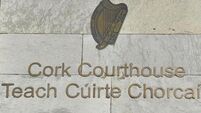Cloud ‘seeding’ not an option for us
MOST of humanity leaves the weather to the vagaries of nature, but scientists have long since wanted to manipulate or even control it. The idea is that clouds can be “seeded” to produce rain in areas of drought, or to clear fog around airports and other areas where visibility is impaired. This has been tried for decades in arid areas of America, such as Nevada, and also in Russia and China where, last year, efforts were made to ensure the weather remained dry for the ceremonial opening of the Olympic Games in Beijing.
Given our unpredictable weather in Ireland, the concept is interesting. According to Met Éireann, however, cloud “seeding” has not been attempted here. Nor are we likely to see any attempts in the future.
Michael Cummins, a regular reader from Charleville, Co Cork, has been in contact and suggests that efforts ought to be made to introduce the practice here, which is understandable in the light of all the rain we’ve had this year, even in the first two weeks of November.
As weather forecasters continually tell us, starkly, about rain-laden clouds coming in from the Atlantic and heading across the country, would it not be useful if we could get the rain to fall hundreds of miles off the coast, well before it hits land? And wouldn’t it be great, for example, if we could arrange the weather on the day of a Munster final in Cork, or Killarney, so that fans could leave their wet gear at home in the sure knowledge that a specified Sunday was going to be fine.
Cloud “seeding” is a method of making a cloud give up its moisture as rain, especially by releasing particles of dry ice, or silver iodide, into cold clouds. Dry ice freezes water droplets in the cloud, resulting in the formation of raindrops.
Silver iodide particles are used because they have a crystal structure similar to ice and can also lead to raindrop formation. Research began, in 1946, when a small aircraft dropped about 1.5kg of crushed dry ice into supercooled clouds over western Massachusetts, causing rain to fall.
In China, they spend about €100 million a year and employ 50,000 people in rain-making. On the evening of opening of the Olympics, over 1,000 rain dispersal rockets were fired to blow away rain clouds.
It was the largest rain dispersal operation in China and the first time such technology was used to ensure the dry weather for the Olympic opening, said Chinese meteorologists who claimed to have successfully intercepted rain belt that had been moving towards the stadium.
The Beijing weather observatory had given a rainy weather forecast for the Olympic night and rain had been cited as the biggest threat to the opening. As rain stayed away, the four-hour extravaganza in the Bird’s Nest was an exhilarating show that entertained billions around the world.
The artificial rain dispersal efforts basically drove the rain away when the show had been going on for over two hours, experts at the observatory reported.
But cloud “seeding”, controversial in many places, doesn’t always work as planned. On one occasion, the Russian Air Force, during a mission to clear the skies of potentially rain-filled clouds, dropped a mixture of silver iodide, liquid nitrogen and cement powder in an attempt to seed the clouds.
This form of climate modification is common practice in Russia, with attempts to engineer dry days on public holidays and special events in Moscow, for instance. However, during this operation, cement dropped from one of the aircraft failed to fragment when falling through the air and crashed as a solid mass through the roof of a Moscow suburban home.
Meanwhile, after the wettest summer in Ireland since records began way back in 1866, it looks as if we are going to have to have to put up with whatever comes. Experts tell us one thing is sure – weather patterns will continue to change here.
Irish weather conditions have undergone significant changes in recent years. Of the 15 warmest years on record in Ireland, 10 of these have occurred since 1990. The average temperature has increased by 0.7C during the period 1890-2004 and it continues to rise.
Rainfall is also increasing substantially along the north and west coasts, with only slight increases along the east and south coasts. In some cases, there has even been a decrease in rainfall.
Increased rainfall may result in more seasonal flooding. Some areas have already been experiencing damage from flooding, including parts of Dublin and Cork, Clonmel, Co Tipperary, Newcastlewest, Co Limerick, and Kenmare, Co Kerry.
Rising sea levels are also of serious concern. The EPA has reported that, in 2006. About 60% of the population were living within 10km of the coast. These areas are under severe threat from erosion and flooding.















